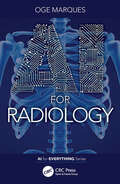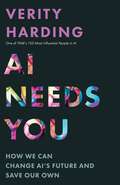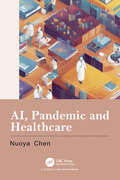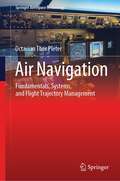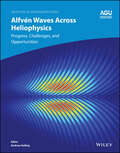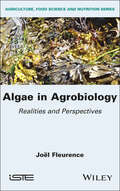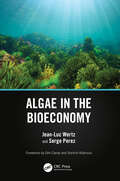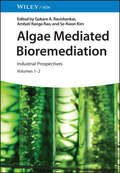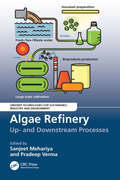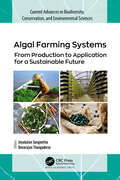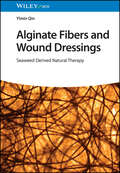- Table View
- List View
AI for Radiology (AI for Everything)
by Oge MarquesArtificial intelligence (AI) has revolutionized many areas of medicine and is increasingly being embraced. This book focuses on the integral role of AI in radiology, shedding light on how this technology can enhance patient care and streamline professional workflows. This book reviews, explains, and contextualizes some of the most current, practical, and relevant developments in artificial intelligence and deep learning in radiology and medical image analysis. AI for Radiology presents a balanced viewpoint of the impact of AI in these fields, underscoring that AI technologies are not intended to replace radiologists but rather to augment their capabilities, freeing professionals to focus on more complex cases. This book guides readers from the basic principles of AI to their practical applications in radiology, moving from the role of data in AI to the ethical and regulatory considerations of using AI in radiology and concluding with a selection of resources for further exploration. This book has been crafted with a diverse readership in mind. It is a valuable asset for medical professionals eager to stay up to date with AI developments, computer scientists curious about AI’s clinical applications, and anyone interested in the intersection of healthcare and technology.
AI for Radiology (AI for Everything)
by Oge MarquesArtificial intelligence (AI) has revolutionized many areas of medicine and is increasingly being embraced. This book focuses on the integral role of AI in radiology, shedding light on how this technology can enhance patient care and streamline professional workflows. This book reviews, explains, and contextualizes some of the most current, practical, and relevant developments in artificial intelligence and deep learning in radiology and medical image analysis. AI for Radiology presents a balanced viewpoint of the impact of AI in these fields, underscoring that AI technologies are not intended to replace radiologists but rather to augment their capabilities, freeing professionals to focus on more complex cases. This book guides readers from the basic principles of AI to their practical applications in radiology, moving from the role of data in AI to the ethical and regulatory considerations of using AI in radiology and concluding with a selection of resources for further exploration. This book has been crafted with a diverse readership in mind. It is a valuable asset for medical professionals eager to stay up to date with AI developments, computer scientists curious about AI’s clinical applications, and anyone interested in the intersection of healthcare and technology.
AI Needs You: How We Can Change AI's Future and Save Our Own
by Verity HardingA humanist manifesto for the age of AIArtificial intelligence may be the most transformative technology of our time. As AI&’s power grows, so does the need to figure out what—and who—this technology is really for. AI Needs You argues that it is critical for society to take the lead in answering this urgent question and ensuring that AI fulfills its promise.Verity Harding draws inspiring lessons from the histories of three twentieth-century tech revolutions—the space race, in vitro fertilization, and the internet—to empower each of us to join the conversation about AI and its possible futures. Sharing her perspective as a leading insider in technology and politics, she rejects the dominant narrative, which often likens AI&’s advent to that of the atomic bomb. History points the way to an achievable future in which democratically determined values guide AI to be peaceful in its intent; to embrace limitations; to serve purpose, not profit; and to be firmly rooted in societal trust.AI Needs You gives us hope that we, the people, can imbue AI with a deep intentionality that reflects our best values, ideals, and interests, and that serves the public good. AI will permeate our lives in unforeseeable ways, but it is clear that the shape of AI&’s future—and of our own—cannot be left only to those building it. It is up to us to guide this technology away from our worst fears and toward a future that we can trust and believe in.
AI Needs You: How We Can Change AI's Future and Save Our Own
by Verity HardingA humanist manifesto for the age of AIArtificial intelligence may be the most transformative technology of our time. As AI&’s power grows, so does the need to figure out what—and who—this technology is really for. AI Needs You argues that it is critical for society to take the lead in answering this urgent question and ensuring that AI fulfills its promise.Verity Harding draws inspiring lessons from the histories of three twentieth-century tech revolutions—the space race, in vitro fertilization, and the internet—to empower each of us to join the conversation about AI and its possible futures. Sharing her perspective as a leading insider in technology and politics, she rejects the dominant narrative, which often likens AI&’s advent to that of the atomic bomb. History points the way to an achievable future in which democratically determined values guide AI to be peaceful in its intent; to embrace limitations; to serve purpose, not profit; and to be firmly rooted in societal trust.AI Needs You gives us hope that we, the people, can imbue AI with a deep intentionality that reflects our best values, ideals, and interests, and that serves the public good. AI will permeate our lives in unforeseeable ways, but it is clear that the shape of AI&’s future—and of our own—cannot be left only to those building it. It is up to us to guide this technology away from our worst fears and toward a future that we can trust and believe in.
AI, Pandemic and Healthcare
by Nuoya ChenThe demand for telehealth solutions has been growing exponentially after the Covid-19 pandemic. Hospitals remain understaffed, which leads to staff burnouts and unsatisfactory patient experience. They also find it difficult to use AI to reduce the workload for doctors and nurses. Doctors barely use data collected from wearables and home-use medical devices to make diagnosis. As generative AI advances, traditional medical device manufacturers are exploring with open innovation to transform into a software-based business model facing competition from large tech companies and startups. This book shares the perspectives from different stakeholders around the challenges of the use of AI in healthcare.
AI, Pandemic and Healthcare
by Nuoya ChenThe demand for telehealth solutions has been growing exponentially after the Covid-19 pandemic. Hospitals remain understaffed, which leads to staff burnouts and unsatisfactory patient experience. They also find it difficult to use AI to reduce the workload for doctors and nurses. Doctors barely use data collected from wearables and home-use medical devices to make diagnosis. As generative AI advances, traditional medical device manufacturers are exploring with open innovation to transform into a software-based business model facing competition from large tech companies and startups. This book shares the perspectives from different stakeholders around the challenges of the use of AI in healthcare.
Air Curtains for Buildings and Industrial Processes (SpringerBriefs in Applied Sciences and Technology)
by Alexander Zhivov Andrey StronginThis book is based on several decades of authors’ research and practical experience in the areas of industrial and commercial buildings ventilation and energy efficiency as well as in process optimization in different types of industrial facilities. The Book discusses different types of air curtains used around the world and describes design, applications, pros and cons and examples for each type of air curtain. The book is illustrated with schematics of air curtains and pictures from their real-life implementation from around-the -world. To compare various design of air curtains, authors propose several indicators/efficiency criteria, which address effectiveness of air curtains, their energy and performance efficiency. The target audience for this book are energy and process engineers and designers of large commercial and industrial facilities, warehouses, and hangars.
Air Navigation: Fundamentals, Systems, and Flight Trajectory Management (Springer Aerospace Technology)
by Octavian Thor PleterThis book takes a new approach to air navigation, extending the classic scope of positioning and guidance to efficient and safe 4D flight trajectory management. Modern air navigation aims at flight trajectories optimisation. There is an infinite number of solutions to the classic navigation problem of flying from one airport to another, but most of them are wasteful of resources and even risky. Minimising all costs and risks incurred by the 4D flight trajectory makes air navigation both efficient and safe, which are key factors in air navigation services. Beyond minimising fuel burn and CO2, efficiency addresses non-CO2 emissions and noise. This is a visually intensive book, using examples and case studies to illustrate the concepts, the physics of navigation and the mathematical models involved. Numerical examples reflect its problem-solving nature. It is useful to aerospace students, engineers, pilots, air traffic controllers, technicians, and scientists curious about aviation.
Air Quality and Human Health
by Markus Hecker Pratap Kumar Padhy Soumya Niyogi Pulak Kumar PatraThe book is one of the outcomes of the SPARC (Scheme for Promotion of Academic and Research Collaboration) project titled "Fine particulates matters in the air environment and their cancer risks in human beings," sponsored by MHRD (now MoE), Govt. of India. The editors of the book are PIs and Co-PIs of the said project. The text deliberates on air pollution's health risks with contributions from well-known experts from diverse research fields (environmental science, toxicology, geology, public health science, biology, physics, chemistry, and geospatial technology). It explores it its control and mitigation strategies. The book provides an up-to-date overview of the modern methods and tools used in air quality monitoring and human health risk assessment. Case studies from different global settings offer invaluable insights into air pollution-related regional health issues. It addresses all aspects of air quality, covering indoor-outdoor air pollution, gaseous and particulate pollutants; characterization of source and pathways of air pollutants; and the modeling and assessing of health risks (respiratory, epidemiological, and toxicological) with regional and global perspectives. It also addresses air quality management issues. The lucid explanation of the role of oxidative stress mechanisms and molecular biomarkers (genomics, proteomics) may be considered as inputs into the development of cancer therapeutics. Along with providing a scientific basis for air pollution, this book will help readers appreciate the environmental determinants of public health and apply research evidence to improve the quality of life. It also delineates future research initiatives and policy actions needed to protect human health from air pollution, locally and globally. The book will be of great educational value and help for consultation and teaching.
Airborne Biocontaminants and their Impact on Human Health
by Rajeev Singh Anamika SinghExplore in-depth the relationships between biological contaminants and human health found in diverse settings such as homes, hospitals, businesses, and schools Indoor air quality has an immense impact on human health and well-being. Indoor air environments can contain a huge range of biological contaminants, including bacteria, fungi, viruses, insects, and their various harmful byproducts. Indoor biocontamination has been under-studied as an aspect of public and occupational health, and there is an urgent need for an introduction to this vital subject. Airborne Biocontaminants and Their Impact on Human Health meets this need with a thorough, rigorous overview of major indoor airborne contaminants. Gathering and summarizing a huge range of data regarding biocontaminants in settings from homes to schools to workplaces, it investigates patterns of morbidity and their connections to major contaminants. The result is an essential tool in the broader fight for human health at home and elsewhere. Airborne Biocontaminants and Their Impact on Human Health readers will also find: Analysis of the indoor role of gases, particulate matter, and others Detailed coverage of contaminant byproducts including endotoxins, mycotoxins, volatile organic compounds, and more Methods for generating awareness and therefore reduced risk of exposure to harmful contaminants Airborne Biocontaminants and Their Impact on Human Health is ideal for researchers—biologists, environmentalists, civil and environmental engineers, industrial hygienists, safety regulators, and public health officials—interested in the area of biological contamination in different environments.
Airborne Biocontaminants and their Impact on Human Health
by Rajeev Singh Anamika SinghExplore in-depth the relationships between biological contaminants and human health found in diverse settings such as homes, hospitals, businesses, and schools Indoor air quality has an immense impact on human health and well-being. Indoor air environments can contain a huge range of biological contaminants, including bacteria, fungi, viruses, insects, and their various harmful byproducts. Indoor biocontamination has been under-studied as an aspect of public and occupational health, and there is an urgent need for an introduction to this vital subject. Airborne Biocontaminants and Their Impact on Human Health meets this need with a thorough, rigorous overview of major indoor airborne contaminants. Gathering and summarizing a huge range of data regarding biocontaminants in settings from homes to schools to workplaces, it investigates patterns of morbidity and their connections to major contaminants. The result is an essential tool in the broader fight for human health at home and elsewhere. Airborne Biocontaminants and Their Impact on Human Health readers will also find: Analysis of the indoor role of gases, particulate matter, and others Detailed coverage of contaminant byproducts including endotoxins, mycotoxins, volatile organic compounds, and more Methods for generating awareness and therefore reduced risk of exposure to harmful contaminants Airborne Biocontaminants and Their Impact on Human Health is ideal for researchers—biologists, environmentalists, civil and environmental engineers, industrial hygienists, safety regulators, and public health officials—interested in the area of biological contamination in different environments.
Aircraft Fatigue Management (SpringerBriefs in Applied Sciences and Technology)
by Lorrie MolentFatigue occurs under cyclic loading and can significantly degrade the operational capability and safety of metallic aircraft components and structures. This book provides summaries of some metallic aircraft structural integrity issues, innovative but established examples of maintaining operational capability—airworthiness, and assessments of safe in-service fatigue lives. These topics are based on a through-life fatigue management philosophy that ensures safe and continued operation, including during life extensions that are almost inevitably required. This philosophy is underpinned by observations of the behaviour of fatigue cracks in actual structures subjected to realistic service loading conditions. The book includes topics like aircraft design requirements, individual aircraft fatigue loads monitoring, airframe fatigue testing, sources of fatigue-nucleating discontinuities, and prediction of fatigue crack growth from these discontinuities. All these aspects contribute to discussing methods of assuring the structural integrity and operational capability of realistically cracked structures. The book also discusses the exponential behaviour of lead or dominant cracks—those leading to first failure—and the practical significance of differences between fatigue fracture topographies produced under constant amplitude and variable amplitude loading. The book can be a valuable reference for researchers and professionals interested in aircraft fatigue management and allied fields.
Alfvén Waves Across Heliophysics: Progress, Challenges, and Opportunities (Geophysical Monograph Series)
by Andreas KeilingAlfvén Waves Across Heliophysics Progress, Challenges, and Opportunities Alfvén waves are fundamental to the dynamics of space plasmas. Recent advances in our knowledge about Alfvén waves have come from several directions, including new space missions to unexplored heliospheric regions, sophisticated rocket campaigns in the auroral zone, enlarged magnetometer arrays and radar networks, and significant advances in computer modeling. Alfvén Waves Across Heliophysics: Progress, Challenges, and Opportunities is an interdisciplinary collaboration from different space science communities to review recent and current Alfvén wave research. Volume highlights include: Alfvén waves in the solar atmosphereAlfvén waves at the giant planetsAlfvén waves at MarsAlfvén waves in moon-magnetosphere systemsAlfvén waves in geospaceAlfvén waves in the laboratory The American Geophysical Union promotes discovery in Earth and space science for the benefit of humanity. Its publications disseminate scientific knowledge and provide resources for researchers, students, and professionals.
Alfvén Waves Across Heliophysics: Progress, Challenges, and Opportunities (Geophysical Monograph Series)
by Andreas KeilingAlfvén Waves Across Heliophysics Progress, Challenges, and Opportunities Alfvén waves are fundamental to the dynamics of space plasmas. Recent advances in our knowledge about Alfvén waves have come from several directions, including new space missions to unexplored heliospheric regions, sophisticated rocket campaigns in the auroral zone, enlarged magnetometer arrays and radar networks, and significant advances in computer modeling. Alfvén Waves Across Heliophysics: Progress, Challenges, and Opportunities is an interdisciplinary collaboration from different space science communities to review recent and current Alfvén wave research. Volume highlights include: Alfvén waves in the solar atmosphereAlfvén waves at the giant planetsAlfvén waves at MarsAlfvén waves in moon-magnetosphere systemsAlfvén waves in geospaceAlfvén waves in the laboratory The American Geophysical Union promotes discovery in Earth and space science for the benefit of humanity. Its publications disseminate scientific knowledge and provide resources for researchers, students, and professionals.
Algae in Agrobiology: Realities and Perspectives
by Joel FleurenceAlgae, macroalgae and microalgae can be valuable biological resources in a new, more environmentally friendly form of agriculture known as agrobiology. Indeed, the biological properties associated with algae are frequently relevant for agricultural and zootechnical purposes. It is this aspect that is behind the current popularity of algae in the development of new agricultural practices that are related to plant and animal production, which are referred to as agrobiology. Algae in Agrobiology offers a current and forward-looking account of algae use: in agriculture and in the sector of land and marine animal production, as algal extracts and molecules in the form of fertilizers or biostimulants for crops with agronomic interest, and as algal compounds in the area of plant and animal health. This book is based on advances in biochemical and agronomic research in order to explain the conventional practices associated with the use of algae in agriculture and livestock breeding. These advances make it possible to establish possible uses for marine algal resources in the agriculture of the future.
Algae in Agrobiology: Realities and Perspectives
by Joel FleurenceAlgae, macroalgae and microalgae can be valuable biological resources in a new, more environmentally friendly form of agriculture known as agrobiology. Indeed, the biological properties associated with algae are frequently relevant for agricultural and zootechnical purposes. It is this aspect that is behind the current popularity of algae in the development of new agricultural practices that are related to plant and animal production, which are referred to as agrobiology. Algae in Agrobiology offers a current and forward-looking account of algae use: in agriculture and in the sector of land and marine animal production, as algal extracts and molecules in the form of fertilizers or biostimulants for crops with agronomic interest, and as algal compounds in the area of plant and animal health. This book is based on advances in biochemical and agronomic research in order to explain the conventional practices associated with the use of algae in agriculture and livestock breeding. These advances make it possible to establish possible uses for marine algal resources in the agriculture of the future.
Algae in the Bioeconomy
by Jean-Luc Wertz Serge PerezAlgae play an important ecological role as oxygen producers and carbon sequesters and are the food base for all aquatic life. Algae are economically important as a source of crude oil, food and feed, and pharmaceutical and industrial products. High-value and sustainable products from algae are already economically viable and can be a fundamental driver for fuel production. Algae in the Bioeconomy provides a detailed overview of the chemical composition of algae and shows that an integrated biorefinery approach is necessary for large-scale algae production and conversion, where multiple products are produced. This book serves as a unique compendium of knowledge covering the essential features of algae and their applications. Discusses the structural chemistry and biology of micro- and macroalgal components Describes classification, occurrence, conversion, and production of micro- and macroalgae Offers strategies for optimal use of micro- and macroalgae in the bioeconomy, including regional strategies in the EU, US, China, India, Malaysia, Norway, and Chile Features forewords from international experts offering both a scientific and an economic/strategic viewpoint This book is intended for an interdisciplinary audience in chemical engineering, biotechnology, and environmental science and engineering, promoting research, development, and application of algae as a sustainable resource.
Algae in the Bioeconomy
by Jean-Luc Wertz Serge PerezAlgae play an important ecological role as oxygen producers and carbon sequesters and are the food base for all aquatic life. Algae are economically important as a source of crude oil, food and feed, and pharmaceutical and industrial products. High-value and sustainable products from algae are already economically viable and can be a fundamental driver for fuel production. Algae in the Bioeconomy provides a detailed overview of the chemical composition of algae and shows that an integrated biorefinery approach is necessary for large-scale algae production and conversion, where multiple products are produced. This book serves as a unique compendium of knowledge covering the essential features of algae and their applications. Discusses the structural chemistry and biology of micro- and macroalgal components Describes classification, occurrence, conversion, and production of micro- and macroalgae Offers strategies for optimal use of micro- and macroalgae in the bioeconomy, including regional strategies in the EU, US, China, India, Malaysia, Norway, and Chile Features forewords from international experts offering both a scientific and an economic/strategic viewpoint This book is intended for an interdisciplinary audience in chemical engineering, biotechnology, and environmental science and engineering, promoting research, development, and application of algae as a sustainable resource.
Algae Mediated Bioremediation: Industrial Prospectives, 2 Volumes
by G. A. Ravishankar A. Ranga Rao Se-Kwon KimAlgae Mediated Bioremediation Develop new methods for remediating pollution with this cutting-edge guide In a world where environmental remediation and pollution removal are becoming more critical with every passing day, the search for organic and sustainable solutions has never been more critical. Removing organic pollutants through the use of algae has become an especially promising avenue for bioremediation, with a far lower environmental impact than comparable mechanical, physical, or chemical approaches. The possibility of deriving bioenergy from the resulting biomass makes this approach even more potentially critical to a sustainable future. Algae Mediated Bioremediation offers a cutting-edge overview of these processes and their applications. Its comprehensive approach to the problems of pollution abatement and the value of algae as environmental and biotechnological agents include both practical solutions and key gaps in existing research. Algae Mediated Bioremediation readers will also find: Case studies of successful use drawn from across the globe Detailed discussion of remediating aquatic, atmospheric, and terrestrial habitats Applications for value-added products incorporating biomass Algae Mediated Bioremediation is ideal for biotechnologists, biochemists, natural products chemists, and other researchers working in industry or environmental research.
Algae Mediated Bioremediation: Industrial Prospectives, Volumes 1 - 2
by Gokare A. Ravishankar Ambati Ranga Rao, Se-Kwon Kim Se-Kwon KimAlgae Mediated Bioremediation Develop new methods for remediating pollution with this cutting-edge guide In a world where environmental remediation and pollution removal are becoming more critical with every passing day, the search for organic and sustainable solutions has never been more critical. Removing organic pollutants through the use of algae has become an especially promising avenue for bioremediation, with a far lower environmental impact than comparable mechanical, physical, or chemical approaches. The possibility of deriving bioenergy from the resulting biomass makes this approach even more potentially critical to a sustainable future. Algae Mediated Bioremediation offers a cutting-edge overview of these processes and their applications. Its comprehensive approach to the problems of pollution abatement and the value of algae as environmental and biotechnological agents include both practical solutions and key gaps in existing research. Algae Mediated Bioremediation readers will also find: Case studies of successful use drawn from across the globe Detailed discussion of remediating aquatic, atmospheric, and terrestrial habitats Applications for value-added products incorporating biomass Algae Mediated Bioremediation is ideal for biotechnologists, biochemists, natural products chemists, and other researchers working in industry or environmental research.
Algae Refinery: Up- and Downstream Processes (Greener Technologies For Sustainable Industry And Environment)
Algae Refinery: Up- and Downstream Processes offers complete coverage of algae refinery, including up- and downstream processes while proposing an integrated algal refinery for the advancement of existing technologies and summarizing the strategies and future perspectives of algal refinery. It provides a concise introduction to the algal science, biology, technology, and application of algae. It explains downstream and upstream steps of algal refinery for the production of algal biomass, with several social benefits. Features: Provides various aspects of algal bioprocess including upstream and downstream processes Explains the major research streams of algae structures and their pathways Covers algal-based CO2 capture technology Explores the potential applications of algae for socioeconomical benefits Deliberates algal bioremediation approach for clean and sustainable development
Algae Refinery: Up- and Downstream Processes (Greener Technologies For Sustainable Industry And Environment)
by Sanjeet Mehariya Pradeep VermaAlgae Refinery: Up- and Downstream Processes offers complete coverage of algae refinery, including up- and downstream processes while proposing an integrated algal refinery for the advancement of existing technologies and summarizing the strategies and future perspectives of algal refinery. It provides a concise introduction to the algal science, biology, technology, and application of algae. It explains downstream and upstream steps of algal refinery for the production of algal biomass, with several social benefits. Features: Provides various aspects of algal bioprocess including upstream and downstream processes Explains the major research streams of algae structures and their pathways Covers algal-based CO2 capture technology Explores the potential applications of algae for socioeconomical benefits Deliberates algal bioremediation approach for clean and sustainable development
Algal Farming Systems: From Production to Application for a Sustainable Future (Current Advances in Biodiversity, Conservation, and Environmental Sciences)
by Jeyabalan Sangeetha Devarajan ThangaduraiThe farming and cultivation of algae can provide sustainable solutions for issues like food security-related problems, costly health-related products, sustainable fuels, and more. However, the use of algae is currently restricted to high-value, low-volume markets, mainly due to the high investment and production costs involved. In recent years, algaculture for food and fuel purposes has begun a transition from R&D and pilot-scale operations to commercial-scale systems. This new book presents the latest technological innovations in algae production, market status, and prospects for algal applications.The book provides an informative overview of different perspectives on the commercial production of algae-based food, health, and high-value cosmeceutical products, providing an institutional framework to support and promote the development and commercialization of algal farming. The book discusses phycotechnology and highlights the current trends and future scope of algal technology. It also presents new information on algal culture conditions and cultivation strategies, including a look at geographic position and local climate as key factors in the implementation of microalgae-based processes. Algal production, marketing strategies, and their commercialization are discussed, as are the industrial applications of algae, focusing mainly on nutraceutical, pharmaceutical, and cosmeceutical applications of microalgae and macroalgae.
Algal Farming Systems: From Production to Application for a Sustainable Future (Current Advances in Biodiversity, Conservation, and Environmental Sciences)
The farming and cultivation of algae can provide sustainable solutions for issues like food security-related problems, costly health-related products, sustainable fuels, and more. However, the use of algae is currently restricted to high-value, low-volume markets, mainly due to the high investment and production costs involved. In recent years, algaculture for food and fuel purposes has begun a transition from R&D and pilot-scale operations to commercial-scale systems. This new book presents the latest technological innovations in algae production, market status, and prospects for algal applications.The book provides an informative overview of different perspectives on the commercial production of algae-based food, health, and high-value cosmeceutical products, providing an institutional framework to support and promote the development and commercialization of algal farming. The book discusses phycotechnology and highlights the current trends and future scope of algal technology. It also presents new information on algal culture conditions and cultivation strategies, including a look at geographic position and local climate as key factors in the implementation of microalgae-based processes. Algal production, marketing strategies, and their commercialization are discussed, as are the industrial applications of algae, focusing mainly on nutraceutical, pharmaceutical, and cosmeceutical applications of microalgae and macroalgae.
Alginate Fibers and Wound Dressings: Seaweed Derived Natural Therapy
by Yimin QinAlginate Fibers and Wound Dressings Comprehensive resource on the science and research behind alginate fibers, along with their many functional applications in different fields Alginate Fibers and Wound Dressings: Seaweed Derived Natural Therapy offers a general introduction to the sources of alginate and the production methods for alginate fibers and wound dressings, in addition to the novel properties and applications of these functional materials in wound management. Taking into consideration of the latest results of clinical researches conducted around the world, this book summarizes the unique properties of alginate wound dressings, including their ‘gel blocking’ properties and the ability to promote wound healing, facilitate haemostasis, reduce pain, suppress bacteria growth, and lower treatment cost in the treatment of a wide range of wounds, including leg ulcers, burn wounds, pressure sores, surgical wounds, and many other types of wounds with high levels of exudates. Sample topics covered in Alginate Fibers and Wound Dressings include: Why alginate fibers can be used as a carrier to deliver zinc, copper, silver, and other bioactive metal ions How alginate wound dressings can help maintain a physiologically moist microenvironment that promotes healing and the formation of granulation tissue Unique properties of alginate fibers that are highly useful for functional textile materials and medical textile products, such as gel forming properties when in contact with body fluid Other excellent performance characteristics of alginate fibers, such as haemostatic, antimicrobial, skin whitening, and many other unique bioactivities Providing comprehensive coverage of the subject, Alginate Fibers and Wound Dressings is an essential resource for students, researchers, and professionals involved in professions and programs of study that intersect with the subject.
